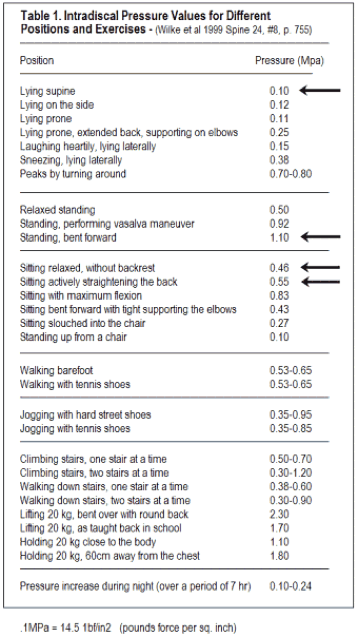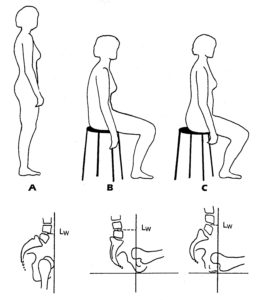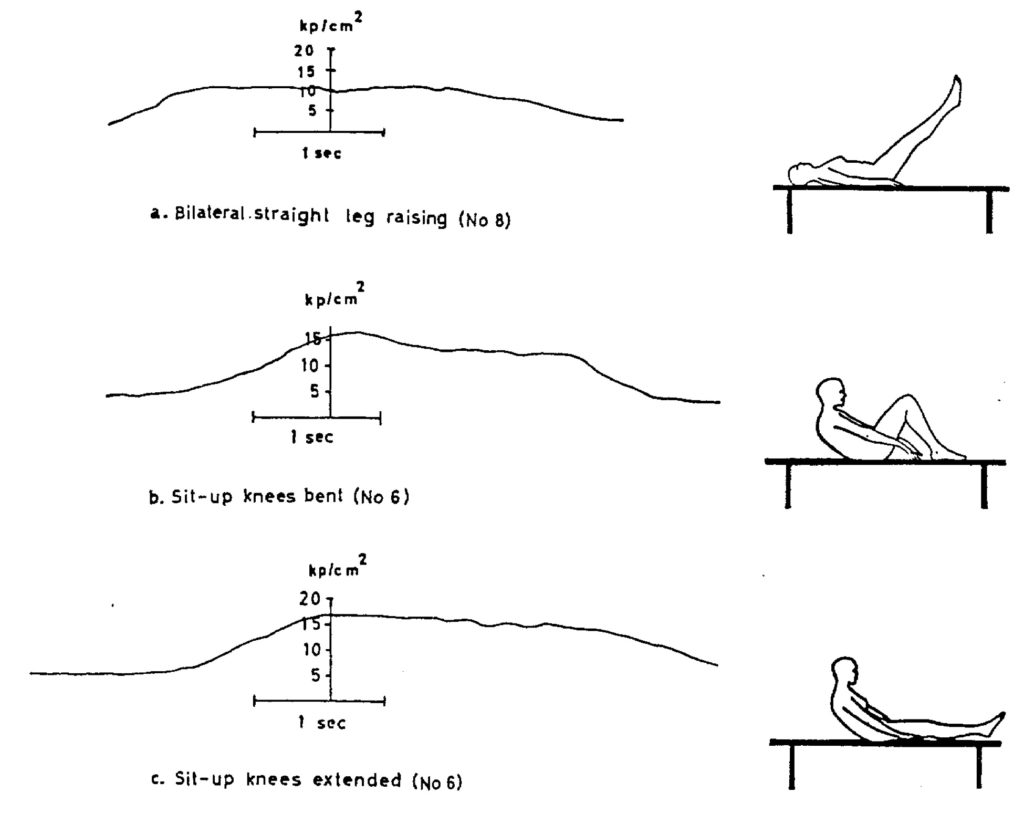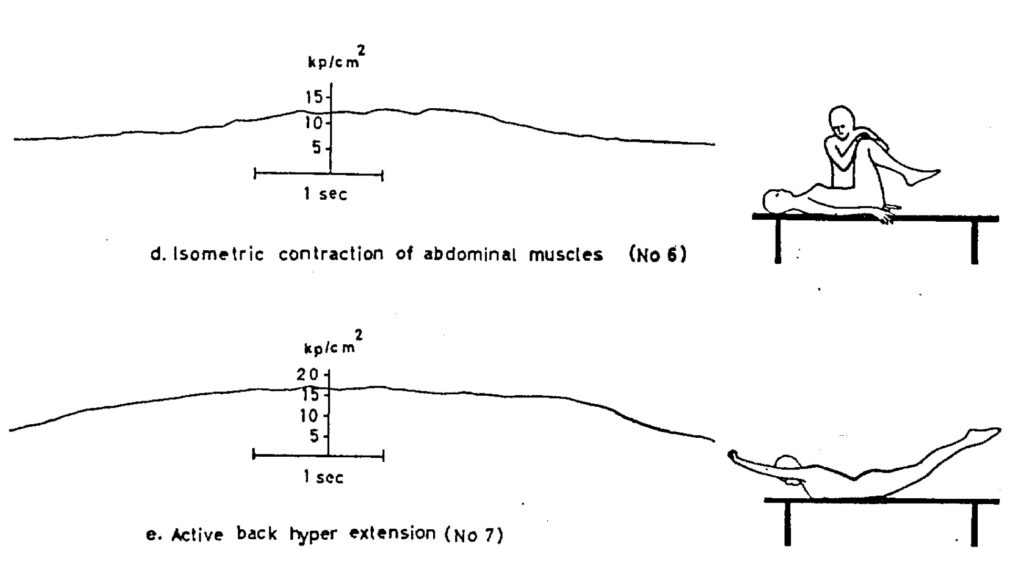Relative increases and decreases in intra-discal pressure in relation to different body positions.
Note that seated and bending postures apply more pressure to the disc than do standing and recumbent positions. This explains the exacerbation of symptoms of herniated disc when patients are in the former positions.

SPINE Volume 24, Number 8, pp 755–762 Hans–Joachim Wilke, PhD, Peter Neef, MD, Marco Caimi, MD, Thomas Hoogland, MD, and Lutz E. Claes,
PhD Department of Orthopedic Research and Biomechanics, Ulm, Germany Department of Physical therapy and Rehabilitation, Basel, Switzerland
Nachemson study was based on research from 1960’s.
New In Vivo Measurements of Pressures in the Intervertebral Disc in Daily Life.
Study Design:
Conducted intradiscal pressure measurements with one volunteer performing various activities normally found in daily life, sports, and spinal therapy.
Objectives:
The goal of this study was to measure intradiscal pressure to complement earlier data from Nachemson with dynamic and long-term measurements over a broad range of activities.
Summary of Background Data:
Loading of the spine still is not well understood. The most important in vivo data are from pioneering intradiscal pressure measure- ments recorded by Nachemson during the 1960s. Since that time, there have been few data to corroborate or dispute those findings.
Methods:
Under sterile surgical conditions, a pressure transducer with a diameter of 1.5 mm was implanted in the nucleus pulposus of a nondegenerated L4–L5 disc of a male volunteer 45-years-old and weighing 70 kg.
Pressure was recorded with a telemetry system during a period of approximately 24 hours for various lying positions; sitting positions in a chair, in an armchair, and on a pezziball (ergonomic sitting ball); during sneezing, laughing, walking, jogging, stair climbing, load lifting; during hydration over 7 hours of sleeping, and others.
Results:
The following values and more were measured:
- Lying prone, 0.1 MPa
- Lying laterally, 0.12 MPa
- Relaxed standing, 0.5 MPa
- Standing flexed forward, 1.1 MPa
- Sitting unsupported, 0.46 MPa
- Sitting with maximum flexion, 0.83 MPa
- Nonchalant sitting, 0.3 MPa
- Lifting a 20-kg weight with round flexed back, 2.3 MPa
- Lifting a 20-kg weight with flexed knees, 1.7 MPa
- Lifting a 20-kg weight with flexed knees and close to the body, 1.1 MPa.
- During the night, pressure increased from 0.1 to 0.24 MPa.
A mega-pascal (MPa) is a decimal multiple of the pascal, which is the SI derived unit of pressure, stress, Young’s modulus and ultimate tensile strength. It is a measure of force per unit area, defined as one newton per square meter.
Conclusions:
Good correlation was found with Nachemson’s data during many exercises, with the exception of the comparison of standing and sitting or of the various lying positions.
Notwithstanding the limitations related to the singel subject design of this study, these differences may be explained by the different transducers used.
t can be cautiously concluded that the intradiscal pressure during sitting may in fact be less than that in erect standing, that muscle activity increases pressure, that constantly changing position is important to promote flow of fluid (nutrition) to the disc, and that many of the physiotherapy methods studied are valid, but a number of them should be re-evaluated.
New in vivo measurements of pressures in the intervertebral disc in daily life.
Hans–Joachim Wilke, PhD, Peter Neef, MD, Marco Caimi, MD, Thomas Hoogland, MD, and Lutz E. Claes, PhD
SPINE Volume 24, Number 8, pp 755–762
Intravital dynamic pressure measurements in lumbar discs. A study of common movements, maneuvers and exercises.
Nachemson A, Elfström G.
Scand J Rehabil Med Suppl. 1970;1:1-40.
Important to note comparison of the two studies
- Study was both in vivo and in vitro.
- Greater number of test subjects were used.
- Neither study pre-qualified the test subjects.
Intravital dynamic pressure measurements in lumbar discs. A study of common movements, maneuvers and exercises.

Intravital dynamic pressure measurements in lumbar discs.
A study of common movements, maneuvers and exercises.
Nachemson A, Elfström G.
Scand J Rehabil Med Suppl. 1970;1:1-40.



